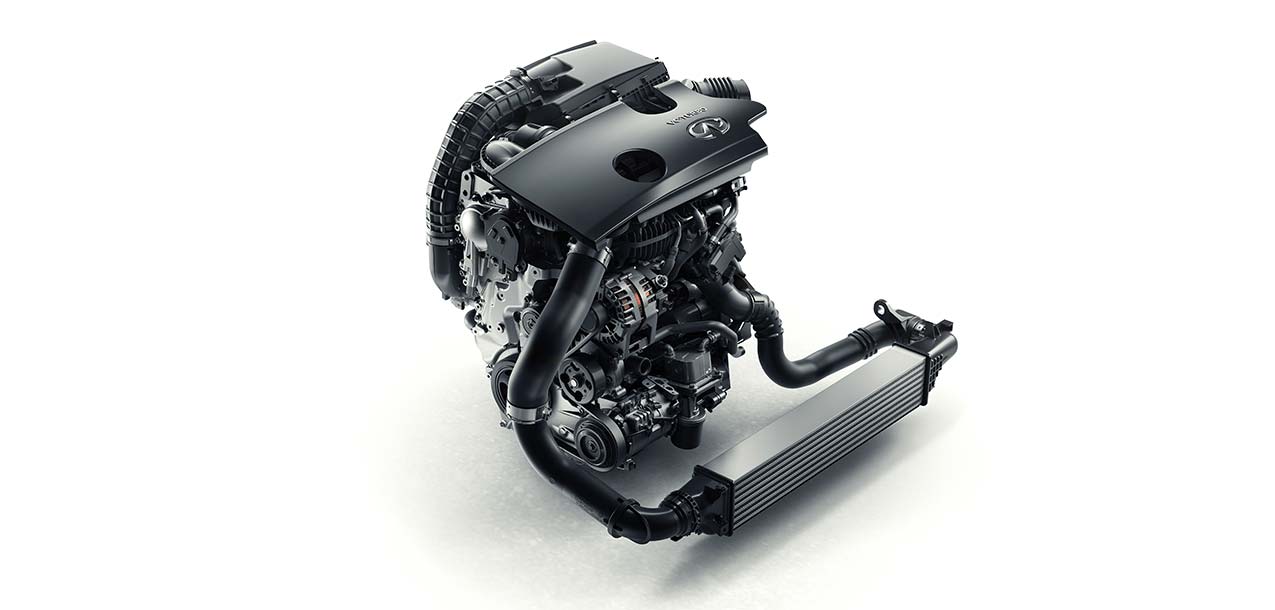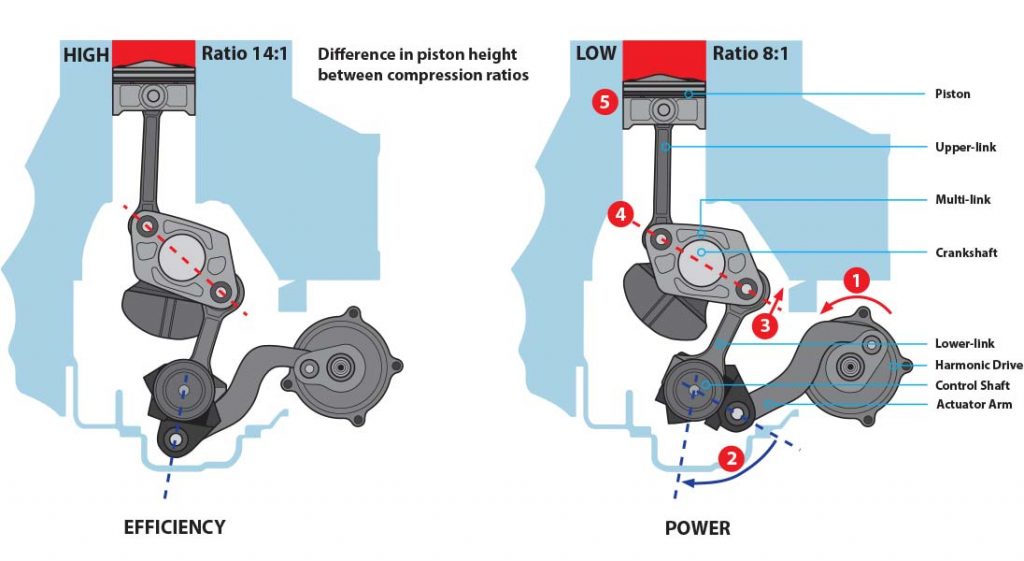“For every action, there’s going to be a reaction. And if the repercussions of the reaction are worse than the benefits of the action, you are going to get screwed.” In automotive engineering, balancing between power and efficiency is crucial. One of the factors that can affect an engine’s power and efficiency is its compression ratio. Automotive technology is moving at an extremely high pace, and after years of development, Infiniti has found a way to play around with the compression ratio and change it in a blink of an eye to balance between efficiency and power.
Text by Bassem Girgis // Photos courtesy of Infiniti Motor Company Ltd. and Joe Singleton
DSPORT Issue #202
Compression Ratio
The compression ratio is the ratio between the swept volume of the cylinder with the piston at bottom dead center (BDC) and the swept volume of the cylinder with the piston at top dead center (TDC). The compression ratio is affected by things like the volume of the cylinder head’s combustion chamber, the piston top design (domed, dishes, flat), the thickness of the head gasket, and the piston-to-deck clearance. Higher compression ratios make the expansion of the combusted gasses greater. This means that more energy is being forced on the top of the piston, which exerts more force on the piston resulting in more torque and better fuel burn. Increasing an engine’s compression ratio improves its thermal efficiency. This means that the engine is able to turn more of the heat generated from the combustion process into horsepower instead of wasted heat. This comes at a price, however, when the thermal efficiency is increased, volumetric efficiency often decreases on forced-induction applications. So, how did Infiniti and Nissan find the balance between power and efficiency through the change in compression ratios? Enter the Variable Compression Engine technology.
Variable Compression Ratio
 Different static compression ratios are good for different conditions, varying from high and low RPM power delivery. For more than 100 years, automakers have been stuck with one static compression ratio per engine. A high static compression ratio squeezes air and fuel mixture in a tighter final volume for greater power and efficiency during the combustion process and power stroke. Since turbochargers and superchargers are designed to force more air into the cylinders, it’s hard to have high compression without experiencing knock. So, how do you get a high compression engine (for power and efficiency) at light loads, then lower the compression ratio when the boost kicks in? Infiniti’s new 2.0-liter Variable Compression turbocharged engine is designed to bring the power along with the efficiency by varying the compression ratio between 8:1 to 14:1 as needed.
Different static compression ratios are good for different conditions, varying from high and low RPM power delivery. For more than 100 years, automakers have been stuck with one static compression ratio per engine. A high static compression ratio squeezes air and fuel mixture in a tighter final volume for greater power and efficiency during the combustion process and power stroke. Since turbochargers and superchargers are designed to force more air into the cylinders, it’s hard to have high compression without experiencing knock. So, how do you get a high compression engine (for power and efficiency) at light loads, then lower the compression ratio when the boost kicks in? Infiniti’s new 2.0-liter Variable Compression turbocharged engine is designed to bring the power along with the efficiency by varying the compression ratio between 8:1 to 14:1 as needed.
Infiniti VC-Turbo Engine
Comparison of VC-Turbo Technology in High and Low Compression Ratios
When the compression ratio needs to be changed, the Harmonic Drive (1) turns to move the Actuator Arm (2). As a result, the Actuator Arm rotates the Control Shaft. When the Control Shaft rotates, it pushes the Lower Link up or down (3) depending on the direction the Harmonic Drive spins. The movement of the Lower Link changes the angle of the Multi-Link (4). The Multi Link’s angle adjusts the height of the Upper Link and Piston (5) to change compression.
How it Works
Through signals from the ECU, the harmonic drive rotates left and right using an electric motor. When the harmonic drive rotates, it moves the actuator arm to rotate the control shaft. As a result, this moves the lower link, which changes the angle of the multi-link. The upper link moves from the multi-link’s rotation, which causes the piston to move up and down to change the compression ratio. The angle of the multi-link determines how high up the upper link and piston will go. If the harmonic drive rotates slightly to the left, the multi-link’s angle will turn to the left, which will pull the upper link down, decreasing the space between the piston and the cylinder head to increase the compression ratio. If it rotates to the right, the multi-link’s angle will change to the right, pushing the upper link and piston higher to decrease the compression ratio.
Infiniti 2.0-Liter VC-T Engine:
Low Compression Mode (8:1): 1997cc displacement
High Compression Mode (14:1): 1971cc displacement
Efficient vs Power Mode
For example, if the engine is operating under boost with a compression ratio of 8:1 and it needs to shift to efficient mode, the harmonic drive would rotate to the left. This would rotate the control shaft, which would pull the lower link down, thus changing the angle of the multi-link to the right. As a result, the upper link will move upwards pushing the piston higher to reduce the space between the piston and the cylinder head to increase the compression ratio to a maximum of 14:1.
Since this engine is turbocharged, a lower compression ratio may be necessary to reliably make power and torque under maximum boost. When cruising and the engine is operating at lower loads, the engine will switch to a higher compression ratio to maximize fuel economy.
There is More
In addition to the Variable Compression technology, the engine can also switch from a traditional Otto engine cycle to the Atkinson cycle by changing valve timing. The intake valves are electronically-controlled as opposed to hydraulically-controlled (like the exhaust valves). Leaving the intake valve open that much reduces pumping losses and enhances the fuel consumption when combined with the high compression ratio. The Infiniti VC-T engine features both port- and direct-injection systems. The direct-injection system operates the entire time, but it changes the number of injections per cylinder. When cruising and at lower engine loads, the port-injection delivers the fuel with one added shot from the direct injectors. At higher loads, the port-injection stops and the fuel is delivered from two shots from the direct injection. Under heavy boost, three shots from the direct-injection delivers all of the fuel. Finally, the new mechanism incorporated in achieving the variable compression reduces piston-to-cylinder wall friction. This happens due to the nearly-vertical angle that the rods are positioned at, thanks to the crankshaft’s offset.
Is it the Future?
A turbocharged engine that can change compression ratios as needed while minimizing piston-to-cylinder wall friction, what’s not to love? Infiniti spent over 20 years developing more than 100 prototypes of their variable compression engine. Testing alone involved more than 30,000 hours of work and 1.8 million miles of road testing. It appears like reliability shouldn’t be an issue at this point, but until we see it thoroughly tested in production vehicles varying in driving styles and conditions, we can’t be fully sold on such brand-new technology.






